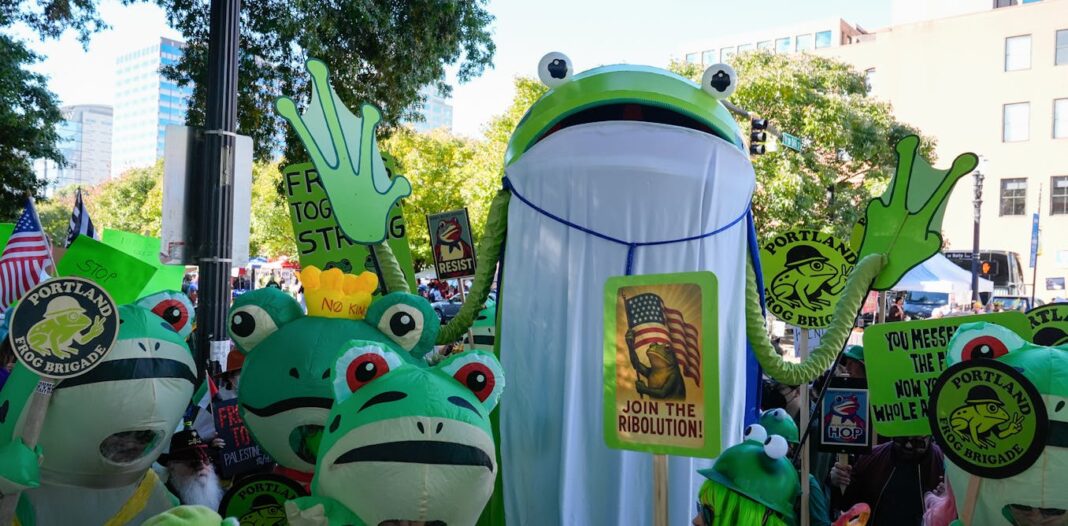A Colorful Resistance: Frogs, Sharks, and Unicorns on the Streets of America
In an unconventional twist of protest, three frogs, a shark, a unicorn, and even a Tyrannosaurus rex are shimmying before a line of heavily armored riot police. This surreal tableau is not just an act of whimsy—it’s a calculated strategy employed by activists across the United States. These inflatable costumes are a deliberate challenge to narratives spun by the Trump administration which brand the protests against Immigration and Customs Enforcement (ICE) as violent “hate America” rallies.
Vibrant Displays of Dissent
Over the past few weeks, these furry and fantastical costumes have transformed the atmosphere surrounding protests, making the encounters between activists and law enforcement not just serious, but hilariously ironic. Video clips of officers confronting these costumed demonstrators have circulated widely, quickly going viral. What these activists are unwittingly doing is continuing a rich tradition of using humor and imaginative dress to challenge and disrupt oppressive power structures.
The Backdrop: ICE Crackdowns
Formed in 2003, ICE has become a controversial body with the authority to enforce immigration laws, leading to widespread arrests and deportations. During Donald Trump’s presidency from 2017 to 2021, the agency’s scope expanded, aiming at many undocumented individuals without criminal records. This escalation sparked the rise of the Occupy ICE movement in June 2018, inspired by the global Occupy movement that sought to combat corporate hegemony and economic disparity.
The first significant Occupy ICE protest exploded in Portland, where activists set up camp and effectively shut down an ICE facility for nearly a week. This encampment is touted by federal officials as “very, very peaceful,” but hints at the collective power of communities rallying for change. With Trump’s re-election, ICE operations intensified yet again, releasing policies that targeted sensitive areas like schools for enforcement.
Operation Inflation: The Power of Absurdity
The recent wave of comedic costuming served as a counter-narrative amidst escalating tensions. For instance, a TikTok featuring an ICE agent spraying pepper spray into the vent of a protester’s inflatable frog costume garnered over two million views. Protester Seth Todd revealed his intention behind donning the froggy facade—to expose the absurdity of police retaliations and to ridicule the administration’s claims of “violent extremists.”
Suddenly, the inflatable frog evolved into not just a costume but an emblem of dissent. The image of the bouncy amphibian appeared across shirts, signs, and street art, resonating so powerfully that activists even launched “Operation Inflation.” This initiative seeks to fund inflatable suits not just for visibility, but to create a playful yet potent space for resistance.
Humor as a Strategic Tool
This playful approach echoes movements around the globe, such as London’s Clandestine Insurgent Rebel Clown Army (CIRCA). They embraced silliness in their anti-war demonstrations, engaging in playful antics that disrupted the usual interactions between police and protesters. Scholar Eve Kalyva describes this as “strategic frivolity”—an intentional embrace of absurdity that redraws the battleground from one of confrontation to one of humor.
In Portland, the inflatable frog faces off against police in riot gear, giving the performance an edge of levity. The juxtaposition paints a stark contrast between the hard-edged authority of law enforcement and the soft, whimsical forms of these costumes, effectively undermining any narratives of aggression.
Historical Context of Costume in Activism
The utilization of costumes in activism isn’t a novelty born of current political climates but rather steeped in history. During the early 20th century, British suffragettes wore meticulously coordinated sashes in purple, white, and green to unify their message in the fight for women’s voting rights. Similarly, the Civil Rights Movement in the U.S. saw individuals marching in their best clothes, asserting dignity amidst racial prejudice.
In recent times, the striking red cloaks of “The Handmaid’s Tale” have become a global symbol of protest against restrictive reproductive rights, while environmental activists don flowing robes to lament ecological loss. Such attire carries powerful messages, transcending mere fabric to convey solidarity and resistance.
The Power of Vulnerability
In a remarkable blend of elements, Portland’s anti-ICE protesters were recently joined by thousands of naked cyclists as part of the Emergency World Naked Bike Ride. This convergence of nakedness and playful costumes enhances the absurdity of protest, exposing the vulnerability of bodies to state violence. The nakedness symbolizes both fragility and defiance, while costumed activists add a layer of humor to stark realities, iterating resilience in the face of oppression.
The Frogs Continue to Multiply
As ICE’s budget for tools of enforcement sees a staggering increase, the movement remains resolute. With slogans like “frogs together strong,” activists armed with humor and vibrant costumes continue to unfurl their message across the country. The juxtaposition of irreverent costumes bursting with life against a backdrop of political strife creates a calling card for protest—a whimsical yet powerful reminder of community strength in adversity. The frogs, sharks, and unicorns are not mere carnival creatures; they symbolize a collective refusal to submit to narratives of fear.



